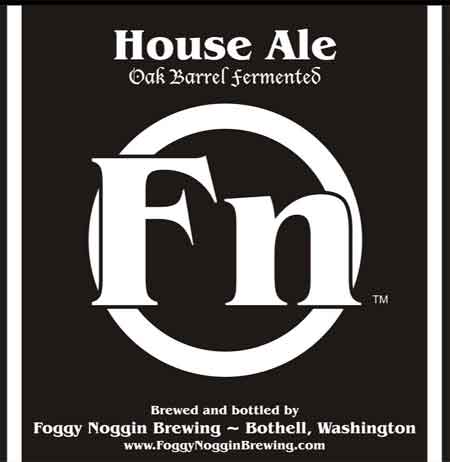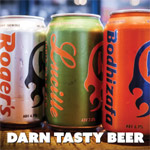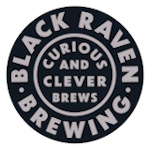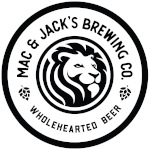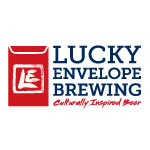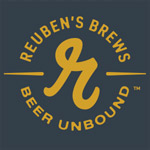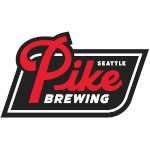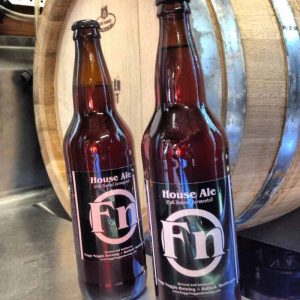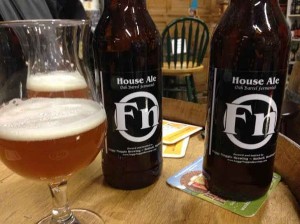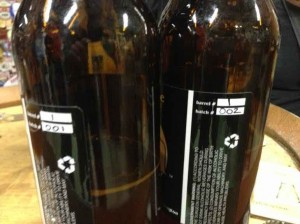Barrel-aged beers are all the rage these days. But what about barrel-fermented beers? This Saturday, February 15, Foggy Noggin Brewing releases the first three batches of its House Ale, an uncommon, barrel-fermented series of beers. Like most of Foggy Noggin’s beers, this one is reminiscent of a traditional English-style ale. But there’s more to this story.
The other day, I sampled the first two batches of House Ale and spent some time at Foggy Noggin with Jim Jamison talking about this very interesting new beer project. The House Ale is an excellent beer. If that’s all you need to know, then I suppose we are done.
To really appreciate Foggy Noggin House Ale, you should know a little bit about Samuel Smith Brewery and The Old Brewery at Tadcaster, Yorkshire. It’s a crucial part of the story. The House Ale is not intended to be a replication of any particular beer, but it is reminiscent of the way things are done in the old country, with Jim’s own twist.
Around here, most people recognize Samuel Smith Brewery for its Oatmeal Stout, and perhaps a couple other beers that are imported by Merchant DuVin. In operation since 1758, The Old Brewery at Tadcaster is one of England’s oldest, still-independent breweries. Currently, it operates under the watchful eye of the current Samuel Smith (I think he is Samuel Smith VI).
A couple years ago, Jim Jamison had an opportunity to meet Samuel Smith. For an American brewer focused on English-style ales, this was a significant event. Jim had many questions. Eventually, he approached the subject of yeast, posing the obvious question, “Can I get some of your yeast?”
Regardless of what the young Yorkshireman did or did not promise that night, the conversation turned into a series of correspondences with the brewery. Eventually Jim learned that the brewery would never, ever shares its yeast. The Samuel Smith yeast strain dates back to the nineteenth century, so Jim really couldn’t have been too surprised to learn that it is protected like the Crown Jewels.
It was worth a shot. You gotta ask.
Jim wasn’t ready to give up and devised a slightly different plan. He knew that White Labs, a top producer and supplier of yeast, offered a yeast that was a knock-off of the Samuel Smith Brewery yeast. Perhaps he could work with that yeast and accomplish the same thing.
From his correspondences with the brewery, Jim learned that the White Labs yeast was a reasonable facsimile of the real thing. In fact, they were a bit perplexed as to how White Labs had knocked it off so well. But there was one big problem. Samuel Smith Brewery ferments its beer in “stone Yorkshire squares” — open fermenting vessels made of solid slabs of slate. NOT stainless steel fermenters. The brewery had never been able to get its yeast to behave as desired in normal fermenters. Truth is, they never cared. Unlike stainless steel, slate is porous and causes the yeast to behave much differently. The fermentation vessels themselves evolve with each fermentation cycle. For better or worse, it’s the way beer has been brewed for over 100 years at the Old Brewery at Tadcaster.
If Jim fermented the beer in stainless steel, the beer would be fine, but it would not have the perpetual, unique character that he wanted.
Jim decided to ferment his House Ale in an oak barrel. Unlike stainless steel, oak would provide the imperfect, porous surface he desired. What’s more, the yeast would be perpetual. The yeast would adopt a new character with each batch, as would the barrel in which the beer is fermented. The goal was to create an ever-changing house character.
“We had a Hungarian Oak barrel made to our specifications, with oak sourced from the Zemplen Forrest – some of the most sought after wood in the world,” says Jim. “Using an ale yeast strain that works best when it is able to not only top ferment, but also from all portions of the fermenter – a whole new character is brought to life. Keeping this yeast perpetual, will allow each half-barrel batch to be unique and ever-evolving.”
Each batch of the House Ale is brewed to spec.
Malts: Maris Otter, Amber, Biscuit, Crystal 45
Hops: Brewers Gold, Fuggles, Goldings
SRM: 11
IBU: 57
ABV: 6.3%
Each half-barrel batch is bottled and marked with the batch number. Approximately 80 bottles per batch make this beer exclusive and rare.
On Saturday, February 15, Foggy Noggin Brewing is releasing the first three batches in its tasting room. Every two weeks another batch will be released. This very limited beer is only available at the Foggy Noggin tasting room.
My tasting notes:
House Ale, batch one. There is something wild about the aroma. Almost dank. The flavor features an earthy hop character. It finishes dry and the oak is quite noticeable, but not overpowering.
House Ale, batch two. Less herbaceous on the nose. More prominent hop character, slightly spicy and almost fruity. Less barrel character (oak), but still dry. An interesting, spicy bitterness lingers.
Both beers are extremely quaffable, a trait not uncommon in Foggy Noggin beers. I’ve yet to taste the third batch, but assume it will be equally delicious, but different.
The first three batches will be released this Saturday, February 15 at Foggy Noggin Brewing.

